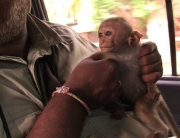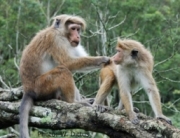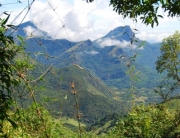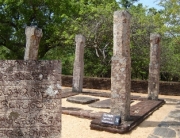Aug 2013, IAAH conference: Dittus & Gunathilake call to align the management of Sri Lanka’s heritage sites with ancient cultural values and UNESCO policy
The following presentation was delivered at the International Conference on Asian Art, Culture and Heritage organized in collaboration with the International Association for Asian Heritage (IAAH) and the Sri Lanka Ministry of Culture and the Arts, held from 21st to 23rd of August 2013
Section: Trends in Heritage Management, Museology and Tourism
Title: A call to align the management of Sri Lanka’s heritage sites with ancient cultural values and UNESCO policy
Authors: Wolfgang Dittus, Ph. D.1,2,3 and Sunil Gunathilake3
Authors’ Institutional Affiliations:
1 Smithsonian Conservation Biology Institute, Washington, DC, USA
2 National Institute of Fundamental Studies, Sri Lanka
3 Association for the Conservation of Primate Diversity, Polonnaruwa
ABSTRACT:
The preservation of Sri Lanka ancient cultural heritage would benefit from a more balanced distribution of emphasis in management and conservation among the different elements that constitute this heritage. The elements of the ancient civilization includes not only (a) the physical remnants of monuments and artifacts, (b) the tanks and irrigation systems, but also (c) the living forest gardens, and the natural environment that buttressed the quality of ancient life. Currently, most archaeological attention and resources are focused on the reconstruction and preservation of ancient stone monuments, infrastructural modernization and tourist management. The ancient cultural heritage, however, extends far beyond monuments.
Forest gardens, for example, were an integral part of the ancient civilizations of South Asia. In Sri Lanka, historical evidence for their existence is widespread being associated with at least 27 sites, the most prominent are known from Sigiriya, Mihintale, Sithulpawa. Rithigala and Polonnaruwa. Their antiquity in Sri Lanka goes back to at least King Mutasiva’s period ( 307-247 BC) (Mahavamsa: Geiger 1912), and their importance to spiritual life was indicated by king Devanampiyatissa (246-206 BC) who venerated the Buddha with a symbol of natural forest when he planted the Bodhi tree in his father’s Maha mevna uyana. Forest gardens were prominent in secular life as well. For example, in the Chulavamsa it is written that King Parakrama Bahu (1153-1186 AD) built a garden of fruit (palaarama) at Lakssha uyana at Polonnaruwa. Other gardens emphasized the esthetic with flowers (pushpaarama) and physical comfort and relaxation with shade trees (punjarama). In his book “A Selection of Indigenous Trees for Traditional Landscape in Sri Lanka” Professor Nimal De Silva illustrates many of the tree and plant species that were important in antiquity and included many varieties of mango that currently are no longer available through modern neglect. Not only were forest gardens an integral part of daily spiritual and secular life, but the importance of the natural world in general was appreciated and extended far beyond managed forest gardens.
In step with Sri Lanka’s Buddhist and Hindu religious traditions, the Mahavamsa chronicles reveal that the ancient kings of Sri Lanka were highly valued the natural world around them. As far back as at least 24 AD, King Amanda Gamini (19-29 AD) banned the killing of all animals. Others, like King Nissanka malla (1187-1196 AD), forbade the destruction of life on land, in the air, and in all waters of his extensive kingdom, and extended this protection to some native trees. Evidence for these royal decrees are found carved in stone among the archaeological remnants of these kings’ palaces and temples at Polonnaruwa, Mihintale and Anuradhapura. The king’s’ proclamations over many centuries were the equivalent to the establishment of the world’s first official nature sanctuaries.
Given this ancient tradition, it is particularly poignant that, aside from rhetoric, Sri Lanka’s natural heritage is losing ground to narrow interests. The ongoing neglect and even trashing of the natural aspects of Sri Lanka’s heritage sites is at odds with ancient cultural precedents and UNESCO guideline qualifications for global heritage sites.






